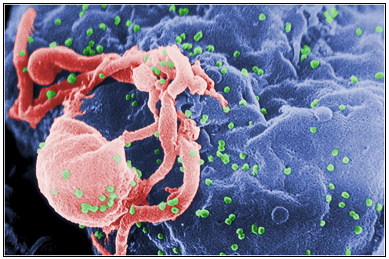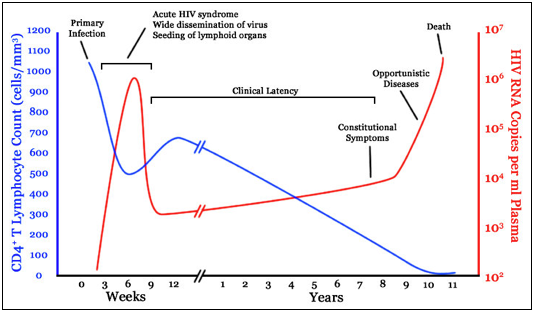Let’s talk!
In 1981, the U.S. Centers for Disease Control and Prevention first recognized the first cases of AIDS in five homosexual men in Los Angeles. In 1983, the HIV virus was “officially” identified.
HIV/AIDS is presently a global epidemic (or pandemic) with 30â40 million of the adult world population infected. Although this disease has been discussed often, I will review some of its less-known and controversial features.
The human immunodeficiency virus (HIV) has been linked to the development of autoimmune immunodeficiency syndrome (AIDS). Because it takes many years to show any symptoms or signs of this disease, HIV is considered a sexually transmitted infection (STI).
A virus is a very small infectious agent that needs to invade living cells of organisms to replicate. It is made of genetic material (DNA or RNA) surrounded by a protein envelope.
HIV is a retrovirus, which means it carries its genetic material in the form of RNA instead of DNA (see picture below). There are two types of HIV viruses: HIV-1 and HIV-2. Both types of HIV can lead to AIDS, but type 2 is rare (it is mostly found in West Africa) and less easily transmitted.
 Electron Microscope Picture of HIV
Electron Microscope Picture of HIV
HIV-1 can be classified into 4 groups: M, O, N, and P. The M group is further divided into subtypes A, B, C, D, F, G, H, J, and K. Certain subtypes of HIV-1 are found in different countries or regions. For example, subtype B is mostly found in Europe, the Americas, Japan, and Australia.
The controversy that surrounds HIV is that the virus has not been isolated. Even when a person is in the end stage of AIDS, no whole self-infecting HIV was found in the blood. The only way to know if someone has been in contact with this virus is by testing for antibodies that the immune system produces. The pictures of HIV found in the medical literature are made with electron microscopes in laboratories capturing highly contaminated cells by other foreign bodies.
Dr. Jonas Salk (inventor of the polio vaccine) stated that HIV may be 900 years old. There is extensive data on retroviruses and these infectious agents co-exist in cells – they do not destroy their hosts. Also, the original HIV strain that jumped from chimpanzees to humans has never been isolated.
According to mainstream Western medicine, HIV infections follow a predictable disease progression pattern (see diagram below). A person is most contagious between 3 to 6 weeks after being infected by HIV. By the 7th week, the immune system usually responds by killing a good portion of the HIV virus and the infected T cells.
The latent phase of the disease starts around the 9th week, during which the viral load is relatively low and can stay at that level for about 5 years. Ten years after the initial infection, the normal T cell count (500-1500 cells/mm3) drops below 200 cells/mm3 and the person has developed AIDS.
World-renowned Virologist Peter Duesberg Ph.D. has challenged this theory. According to him, the original cases of AIDS were the result of already compromised immune systems due to the long-term consumption of recreational drugs and other poor lifestyle choices in the gay community.
A large US army study conducted and published 1992 associated with becoming HIV positive with syphilis. Syphilis was the single condition that increased by 40 times the likelihood of having an HIV positive diagnosis. In the American gay male population of the early 1980s, many men had hundreds of sexual partners which made them susceptible to a wide range of STDs. It is estimated that chronic syphilis may account for 70% of AIDS while the remaining 30% may be due to a combination of herpes, HIV, chlamydia, poor nutrition, alcohol consumption, illegal drug use, and lack of sleep.
According to Chemistry Nobel Laureate Kary Mullis Ph.D., the apparent epidemic of AIDS in Africa is misleading. He argues that the use of invalid blood tests combined with severely compromised immune systems due to poor nutrition, wars, and diseases, has created the false belief that many African countries are decimated by AIDS.
Antiviral therapy consists of highly active antiretroviral therapy (HAART). This therapy is a combination (or cocktail) of at least 3 drugs belonging to at least 2 types of antiretroviral agents. HAART is very toxic and most of these drugs were designed for short-term use on cancer patients. Over time, HIV patients experience many side effects with HAART (i.e., rash, liver toxicity, cardiovascular disease) that precipitate their death.
HIV/AIDS is no longer the disease of gay men or drug users. In 30 years, it has gone from a cluster of isolated cases to an apparent global epidemic. Everybody is touched directly or indirectly by this disease. HAART therapies are very expensive/toxic drugs with no proven track record to prolonging the life of HIV infected individuals. Access to proper nutrition, clean water, education, decent housing may be the first steps to control AIDS worldwide. Most importantly, it is critical that the medical community and laypeople continue to question the HIV=AIDS theory.
Literary Truths
Here are some recent statistics about AIDS/HIV:
- In North America, more money is spent on AIDS research than on cancer research.
- HIV transmission is unlikely in a single unprotected heterosexual encounter if the uninfected person is healthy. The odds are about 1 in 1000.
- In Canada, gay, bisexual, and other men who have sex with men still represent the greatest proportion (44%) of new HIV infections.
- Almost 45% (17.7 million) of the reported global HIV-infected population is female.
- Only 2% of T4 cells are in the blood. It is not possible to determine the health of a person’s immune system by a blood test.
- India has a population of about 1 billion but has among the lowest percentage (0.34%) of reported of HIV/AIDS cases.
Truth in Motion
References
AIDS Inc. movie
Asin, Susana N., et al. “Estradiol and progesterone regulate HIV type 1 replication in peripheral blood cells.” AIDS Research and Human Retroviruses 24.5 (2008): 701.
Chu, Carolyn, and Peter A. Selwyn. “Current health disparities in HIV/AIDS.” The AIDS Reader 18.3 (2008): 144.
Fernet, Mylene, et al. “Issues of sexuality and prevention among adolescents living with HIV/AIDS since birth. (Report).” The Canadian Journal of Human Sexuality 16.3-4 (2007): 101.
Hans Rosling on HIV: New facts and stunning data visuals
Heltzer, Ned E. “Adverse effects of antiretroviral therapy differ by race and sex.” The AIDS Reader 18.7 (2008): 348.
HIV types, subtypes, groups & strains
Leonard, Amy D., et al. “Lowering the risk of secondary HIV transmission: insights from HIV-positive youth and health care providers.” Perspectives on Sexual and Reproductive Health 42.2 (2010): 110.
Parkhurst, Justin O., and Alan Whiteside. “Innovative responses for preventing HIV transmission: the protective value of population-wide interruptions of risk activity.” Southern African Journal of HIV Medicine 37 (2010): 19.
Public Health Agency of Canada
Stenehjem, Edward, and Judith C Shlay. “Sex-specific differences in treatment outcomes for patients with HIV and AIDS.” Expert Review of Pharmacoeconomics & Outcomes Research 8.1 (2008): 51.

